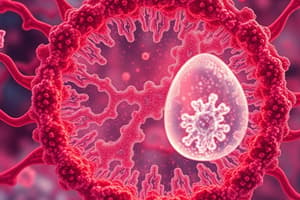Podcast
Questions and Answers
What are sister chromatids?
What are sister chromatids?
- Homologous chromosomes from different parents
- Chromosomes that have not yet duplicated
- Two identical copies of a chromosome joined at the centromere (correct)
- Chromosomes that have undergone crossing over
During which phase does DNA replication occur?
During which phase does DNA replication occur?
- Mitosis
- G1 Phase
- G2 Phase
- S Phase (correct)
What occurs during anaphase of mitosis?
What occurs during anaphase of mitosis?
- Chromosomes condense
- Nuclear membrane breaks down
- Sister chromatids separate and move to opposite poles (correct)
- Spindle fibers form
What is the main outcome of meiosis?
What is the main outcome of meiosis?
What happens during prophase of mitosis?
What happens during prophase of mitosis?
Which type of cells are diploid?
Which type of cells are diploid?
How does genetic variation occur during meiosis?
How does genetic variation occur during meiosis?
What is the result of cytokinesis?
What is the result of cytokinesis?
Flashcards are hidden until you start studying
Study Notes
Duplicated Chromosomes
- Chromosomes duplicate during cell division, resulting in two identical copies called sister chromatids.
- Sister chromatids are joined together at the centromere.
- Diploid cells contain two sets of chromosomes, one from each parent.
- Haploid cells contain only one set of chromosomes.
- Homologous chromosomes are pairs of chromosomes that have similar genes, with one chromosome from the mother and the other from the father.
Cell Cycle
- The cell cycle consists of two main phases: interphase and mitosis.
- Interphase is the period of growth and preparation for cell division.
- G1 phase: The cell grows and carries out normal metabolic functions.
- S phase: DNA replication occurs, creating two identical copies of each chromosome.
- G2 phase: The cell prepares for division, and duplicated DNA is in a chromatin form.
- Mitosis is the division of the nucleus and involves four stages:
- Prophase: Chromosomes condense, the nuclear membrane breaks down, and spindle fibers form.
- Metaphase: Chromosomes line up at the middle of the cell.
- Anaphase: Sister chromatids separate and move to opposite poles.
- Telophase: Chromosomes reach the opposite poles, and the nuclear membrane reforms around each set of chromosomes.
- Cytokinesis is the division of the cytoplasm, resulting in two separate daughter cells.
Meiosis
- Meiosis is a type of cell division that produces genetically different haploid cells, essential for sexual reproduction.
- Genetic variation is introduced through the random assortment of chromosomes and crossing over during meiosis.
- Meiosis results in four haploid cells called gametes.
- Gametes fuse during fertilization to form a zygote.
- Each parent contributes at least two alleles, creating genetic diversity in offspring.
Studying That Suits You
Use AI to generate personalized quizzes and flashcards to suit your learning preferences.




